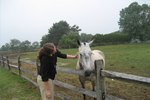
The modern farrier does a lot more than simply nail shoes onto the hooves. The farrier is often the first person a horse owner will call when his horse starts limping or isn't performing to his fullest capability. Farriers are expected to be able to diagnose and treat ailments that affect the hoof as well as provide preventative and corrective treatment for genetic and environmental hoof problems.
A Farrier's Job
The job of a farrier is to maintain the health of the hoof and keep the hoof in good working condition. Hooves grow continuously throughout a horse's life; they need to be trimmed and shaped every 6 to 8 weeks in order to avoid problems. The farrier is the person responsible for doing this. Horse shoes are typically necessary only when a horse's hooves are weak or are wearing down due to activity. An assortment of problems can develop in the hoof, causing lameness issues. Problems include bruising of the soles, abbesses that occur when an infection develops inside the foot and has to work its way out, fungus and even genetic deformity such as a club foot. A good farrier is trained to recognize and test for specific problems as well as instruct the owner how to treat issues that arise. He examines the hoof for signs of weakness, soreness or deformity and applies measures to correct the problems. Treatment can consist of hoof dressings or supplements, a specific type of trim or even specially designed horse shoes. In most cases, regular farrier appointments will significantly reduce the likelihood of a horse developing severe hoof issues.
Farrier School
In order to become a farrier, most candidates attend a specialized college program or training course specifically designed to teach the skills of the trade. Courses vary in length from 8 weeks to a year, depending on the educational institution offering them and the depth of the materials covered. Farriers who have not attended farrier school can still legally practice in the business, but it is becoming increasingly rare for a farrier not to have certified educational training.
Hall of Fame
The International Horseshoeing Hall of Fame is located in Kentucky at the Kentucky Derby Museum. The Hall of Fame was started in 1992 as a way to honor the lifetime achievements of dedicated professional farriers. Farriers are submitted to the Hall of Fame by their clients and other professionals. New inductees are honored every year.
Horse Shoes
While the blacksmiths of the past did double duty by forging their own horse shoes, most of today's farriers simply buy the shoes they use from companies that specialize in making horse shoes. Farriers can change the shape of premade shoes a little bit by hammering them into the right shape, but it is very rare anymore for a farrier to actually make the shoe he is planning on using.
Income
Being a farrier is hard work, but it can pay off. According to Butler Professional Farrier School, the average income of a full-time farrier in the United States in 2011 was $92,000. Since the majority of horses see the farrier every 6 to 8 weeks for their entire lifetimes, a farrier who keeps his clients for 10 years or longer stands to make thousands of dollars off every horse over the course of the horse's life. Barring major medical problems, the owner of a healthy horse is likely to spend significantly more on hoof care than they will at the veterinarian's office over the course of their horse's life.
References
- National Museum of Horse Shoeing Tools and Hall of Honor: Liles Inducted Into International Horseshoeing Hall of Fame
- Montana State University: Farrier School
- The Equinest: Farrier or Blacksmith
- Elpo Farrier School: Student Prerequisites & Requirements
- Absolute Astronomy: Farrier
- Butler Professional Farrier School: Farrier School Is a Better Value Than College
- Young Rider: The Job of a Farrier
Photo Credits
-
Jupiterimages/Pixland/Getty Images
Writer Bio
Jen Davis has been writing since 2004. She has served as a newspaper reporter and her freelance articles have appeared in magazines such as "Horses Incorporated," "The Paisley Pony" and "Alabama Living." Davis earned her Bachelor of Arts in communication with a concentration in journalism from Berry College in Rome, Ga.



